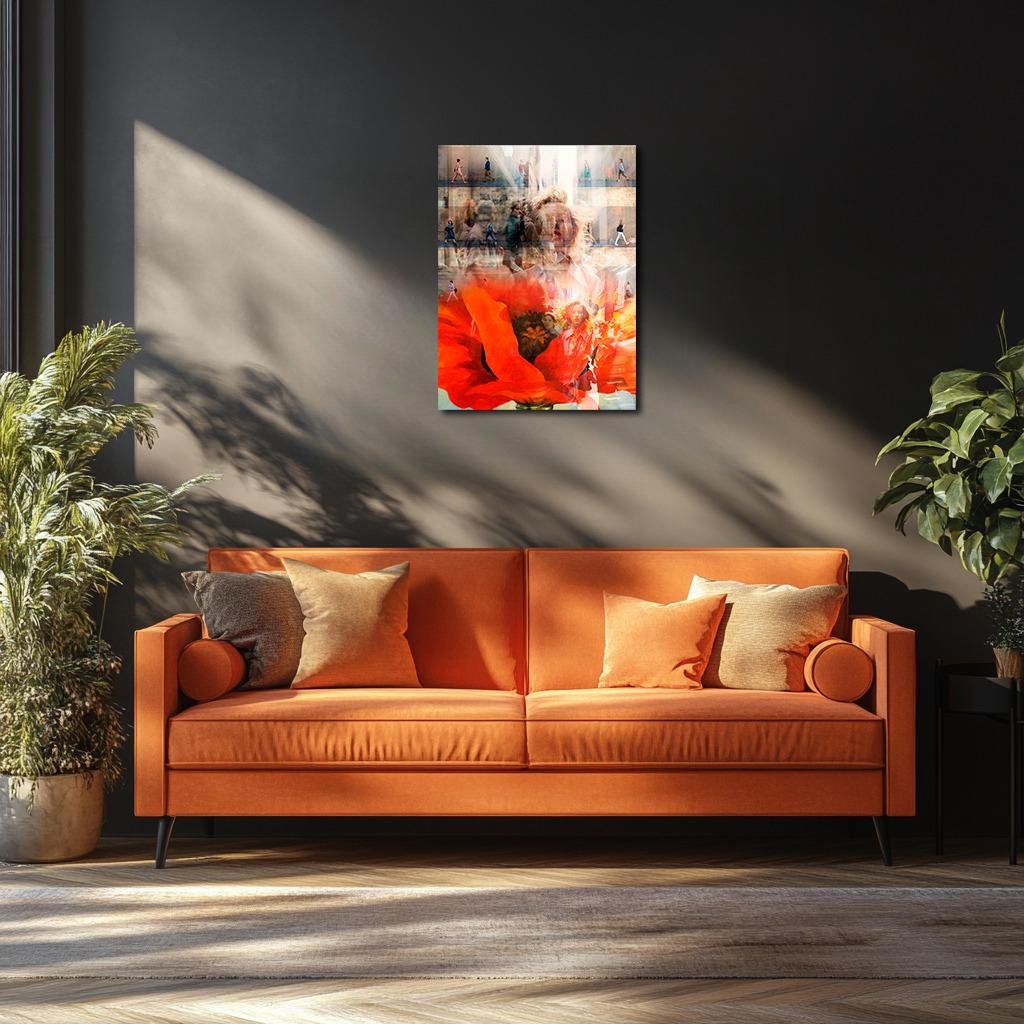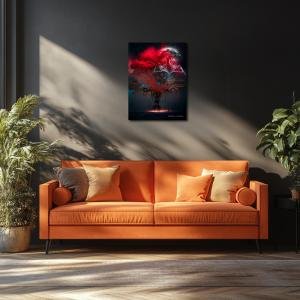Crimson Pulse: Red Poppy
Crimson Pulse transforms Georgia O’Keeffe’s Red Poppy into a vivid act of emotional resistance blooming against the backdrop of modern urban anonymity. With its intense red-orange hues radiating across a sea of blurred walkers and layered faces, the poppy becomes both a lens and a heartbeat—one woman’s presence magnified against the indifference of the crowd. Through a collision of vibrant florals and subdued greys, this reinterpretation reflects on identity, the power of femininity, and the demand to be seen in a world that seldom pauses. The result is a living, breathing canvas of motion and defiance.
Please see Below for Details…
Hotline Order:
Mon - Fri: 07AM - 06PM
404-872-4663
Crimson Pulse reimagines Georgia O’Keeffe’s iconic Red Poppy as a surging wave of presence amid modern anonymity—a flower not nestled in still life but exploding onto a blurred city street, caught in motion, breath, and human disconnection. The original poppy, so lush and solitary in O’Keeffe’s hands, is no longer simply blooming; it’s colliding with the world. Here, it blooms in the heart of a busy avenue, where crowds walk without looking and faces pass like pages of forgotten novels. The poppy’s vivid, red-orange petals become the epicenter of emotion, wrapping around bodies, merging into silhouettes, breathing life into the gray stream of passing time.
The original Red Poppy was never merely a flower—it was a cry of beauty and sensual form, expanded and magnified until it overtook the viewer’s field of vision. This reinterpretation builds upon that vision, placing the bloom not on canvas, but in the psychological center of urban life. The flower is now a lens through which the identity of women, the pulse of movement, and the crush of time all pass. The poppy is not surrounded by silence here; it becomes the silence we forget to hear—a protest of softness in a mechanical world.
Faces overlap like translucent veils. A woman’s contemplative gaze rises at the center, fragmented and refracted across multiple panes of urban passage. Her features are echoed, dissolved, and reconstructed in pieces through the petals—her gaze not passive, but questioning. Who sees her? Where is she in the blur of walking strangers? The lines of commuters at the top and bottom of the frame suggest both routine and isolation, as if the world continues to move while the essence of something sacred—the beauty of a single, unapologetic bloom—waits to be noticed.
The colors carry their own symphony. At the foundation of this visual poem lies the poppy’s core—its scarlet blaze, edged with deep oranges and warm carmine shadows. These tones evoke passion, revolution, sensuality, and protest. Red is the blood of awareness, the heat of existence, the voice that won’t be hushed. Around the red burst, hints of coral and rust feather outward like flames, drawing warmth through the otherwise cool composition. The flower is a heart—beating at the center of a world that doesn’t stop to feel it.
Above this, the middle section is veiled in smoky taupes and hazy greys, a palette echoing fog, memory, and pedestrian melancholy. The bodies walking by—some crisp in motion, others ghosted in blur—wear city colors: navy, beige, asphalt black. These tones carry the mood of people passing each other without meeting. They are the backdrop of the poppy’s loneliness. But they are also the measure of its defiance. Against this subdued palette, the poppy roars its color like a lighthouse cutting fog.
Faces in the middle space are layered, echoing and multiplying as if they are both real and imagined—reflections not just of individuals, but of roles, expectations, emotions suppressed beneath the surface. A golden hue halos some of these figures, softening the greys with a whisper of hope, as if the poppy’s aura is trying to reach them. That golden light flickers into copper and dusty rose, warming the composition with an undercurrent of tenderness and resilience.
This reimagined piece was created with the belief that O’Keeffe’s poppy is not just a flower—it is a voice. In a world where people often walk past beauty, past one another, past themselves, this poppy demands to be seen. It is a mirror of visibility, of feminine power, of emotional fullness refusing to be reduced. It is a protest against erasure, a flare in the still air of routine.
In Crimson Pulse , the poppy is no longer still. It has taken to the streets. It has grown large enough to engulf the anonymous crowd, large enough to shelter a fragmented soul, and red enough to remind the world that beauty is not passive—it is revolutionary.
Add your review
Your email address will not be published. Required fields are marked *
Please login to write review!
Looks like there are no reviews yet.








